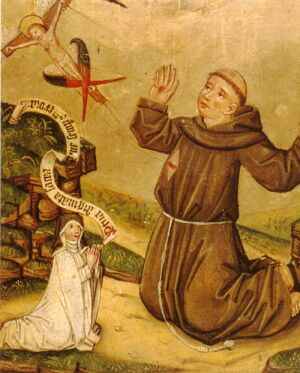Brother Ugolino's The Little Flowers is deeply
reflective of Franciscan spirituality. The narratives not only embody the
core Franciscan values of chastity, poverty, simplicity, and obedience,
but also the whimsy, mysticism, and passion of the movement. Readers new
to this material and to this particular stream of Christian discipleship
often find The Little Flowers to be at once beautiful and
unsettling, both touching and weird. One aspect that can be both moving
and strange is the particular way the narratives and their culture of
origin approach devotion and the life of the body:
- Prophetic Hyperbole: Following on the
tradition of the Hebrew prophets and the Desert ascetics, the
Franciscans inhabit a world of extremes of behavior that are meant to
teach important lessons, to awaken their audiences to another way of
conceiving the world. These actions also act as ways of living beyond
the norm for most people. Thus, they may be subject to ridicule as
well as inspiration, and they serve as jarring moments for the
participants.
- Sacramental Dramatics: In Christian
tradition, a sacrament can be defined as a tangible sign of grace. As
a sign, it is more than a symbol, however. It is a ritualistic
experience of grace communicated through the sign. In this way, the
actions of the Franciscans go beyond the prophetic, they also act as
lived moments of tangible grace where the persons involved meet God.
And this reception of grace is lived before others in ways that move
beyond everyday behavior.
- Romantic Veneration: The veneration of the
saints is not the same thing as the worship of God, yet in this
tradition, the two seem to approach merger at times, perhaps because
of their sacramental quality. The sacrificial extremes of the
Franciscans are treated as both ordinary and yet also as heroic--or
perhaps heroic because they are treated by the friars as
normal. They inspire an emotional reaction in persons that approaches
the devotion of the lover for the beloved in medieval romances. They
create bodily responses in both the actor and the ones observing. And
their hearts are often knit together by deeply emotional fraternity.
Veneration often serves as an overflow of ecstatic worship of God in
Christ, as well as a call upwards to it.
- Christocentric Imitation: All of this
assumes a close identification of the life with Christ, especially
seeking to live a life as Christ did on the earth--living as a
wanderer, as one subject to other's help, not of necessity tied to
place, things, or comfort. This identification extends to a sense of
Christ's suffering, especially at the level of imaginative and bodily
empathy, and it serves as a further expression of great longing for
Christ the Mystical Bridegroom. This Christ-likeness is especially
heightened for St. Francis, who is revered almost as another Christ
come to earth.
Part Two of The Little Flowers, "The
Considerations on the Holy Stigmata" recounts events leading up to
Francis' receiving of the stigmata, the events surrounding his years with
them, and events afterwards--all intended to both inspire the reader and
to document their historical occurrence. I would contend that this deeply
inspiring and/or disturbing texts (depending on your response) bring
together all four of these devotional strains. The stigmata function as
prophetic hyperbole, as sacramental dramatics, as christocentric
imitation, and serve as the heart of romantic veneration for those
surrounding Francis. After we review select passages in class, consider
the following:
|
